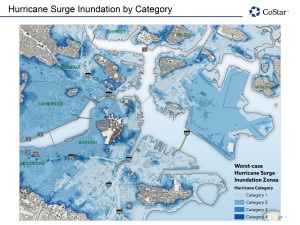Earth is getting so hot that temperatures in about a decade will probably blow past a level of warming that world leaders have sought to prevent, according to a report released Monday that the United Nations called a “code red for humanity.”
“It’s just guaranteed that it’s going to get worse,” said report co-author Linda Mearns, a senior climate scientist at the U.S. National Center for Atmospheric Research. “Nowhere to run, nowhere to hide.”
But scientists also eased back a bit on the likelihood of the absolute worst climate catastrophes like massive, sudden slowdown in ocean currents happening this century.
The authoritative Intergovernmental Panel on Climate Change (IPCC) report, which calls climate change clearly human-caused and “unequivocal,” makes more precise and warmer forecasts for the 21st century than it did last time it was issued in 2013.
While calling the report “a code red for humanity,” U.N. Secretary-General Antonio Guterres kept a sliver of hope that world leaders could still somehow prevent 1.5 degrees Celsius of warming, which he said is “perilously close.”
Local Impacts Visible
Some harm from climate change – dwindling ice sheets, rising sea levels and changes in the oceans as they lose oxygen and become more acidic – is “irreversible for centuries to millennia,” the report said.
The world is “locked in” to 6 to 12 inches of sea level rise by mid-century, said report co-author Bob Kopp of Rutgers University.
For the first time, the report offers an interactive atlas for people to see what has happened and may happen to where they live.
A recent report by The Trustees outlined a dire future for coastal real estate on Martha’s Vineyard and Nantucket due to global warming-caused sea level rise. And Boston officials have outlined a range of coastal defenses, but no agreement has yet been reached on how to pay for them and promised zoning changes have not yet emerged that would help property owners adapt. Statewide, research by the First Street Foundation suggests that nearly 31,000 homes currently outside federally-designated flood zones are at risk of serious damage from worsening coastal flooding linked to climate change.
Five Scenarios Outlined
Each of five scenarios for the future, based on how much carbon emissions are cut, passes the more stringent of two thresholds set in the 2015 Paris climate agreement. World leaders agreed then to try to limit warming to 2.7 degrees Fahrenheit above levels in the late 19th century because problems mount quickly after that. The world has already warmed nearly 2 degrees Fahrenheit since then.
Under each scenario, the report said, the world will cross the 2.7 degrees Fahrenheit (1.5-degree-Celsius) warming mark in the 2030s, earlier than some past predictions. Warming has ramped up in recent years, data shows.
In three scenarios, the world will also likely exceed 3.6 degrees Fahrenheit over pre-industrial times – the less stringent Paris goal – with far worse heat waves, droughts and flood-inducing downpours unless there are deep emissions cuts, the report said.
“Anything we can do to limit, to slow down, is going to pay off,” report co-author Claudia Tebaldi, a scientist at the U.S. Pacific Northwest National Lab, citing emissions reductions already achieved. “And if we cannot get to 1.5, it’s probably going to be painful, but it’s better not to give up.”
Crucial Negotiations Coming Up
With crucial international climate negotiations coming up in Scotland in November, world leaders said the report is causing them to try harder to cut carbon pollution. U.S. Secretary of State Anthony Blinken called it “a stark reminder.”
The 3,000-plus-page report from 234 scientists said warming is already accelerating sea level rise and worsening extremes such as heat waves, droughts, floods and storms. Tropical cyclones are getting stronger and wetter, while Arctic sea ice is dwindling in the summer and permafrost is thawing. All of these trends will get worse, the report said.
For example, the kind of heat wave that used to happen only once every 50 years now happens once a decade, and if the world warms another degree Celsius (1.8 degrees Fahrenheit), it will happen twice every seven years, the report said.
As the planet warms, places will get hit more not just by extreme weather but by multiple climate disasters at once, the report said. That’s like what’s now happening in the Western U.S., where heat waves, drought and wildfires compound the damage, Mearns said. Extreme heat is also driving massive fires in Greece and Turkey.








